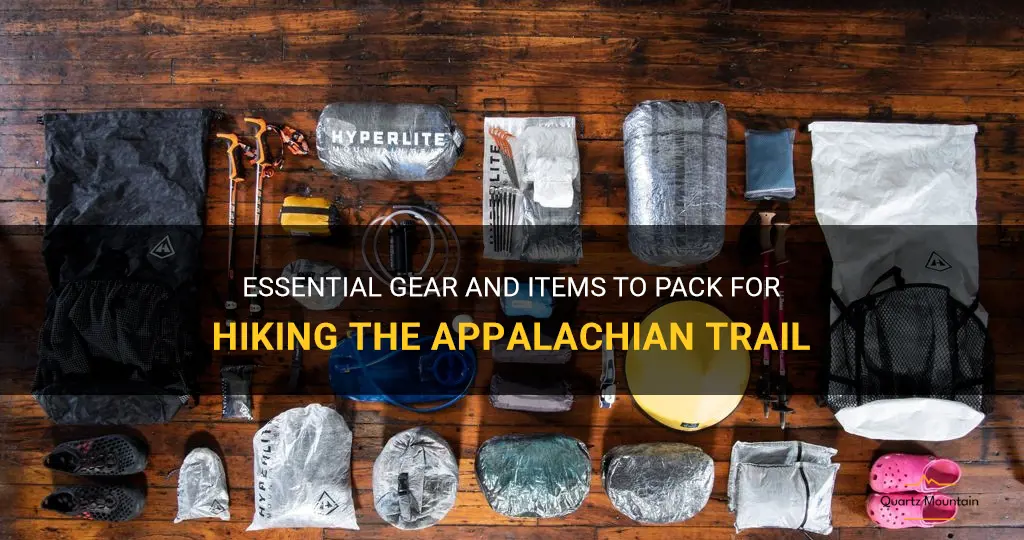
Hiking the Appalachian Trail, a majestic 2,193-mile-long journey through the stunning landscapes of the eastern United States, is no small feat. As hikers embark on this epic adventure, it's essential to have the right gear and items packed to ensure a successful and enjoyable trip. From sturdy hiking boots and lightweight backpacks to essential survival gear, every item serves a purpose in the challenging and rewarding experience of conquering the Appalachian Trail. Let's take a closer look at the essential gear and items that hikers should pack for this unforgettable expedition.
What You'll Learn
- What are the essential items that should be packed for a hike on the Appalachian Trail?
- How should clothing choices be made to accommodate the changing weather conditions on the Appalachian Trail?
- Are there any specific gear or equipment recommendations for hiking the Appalachian Trail?
- What type of footwear is recommended for hiking long distances on the Appalachian Trail?
- Are there any safety items or emergency supplies that should be included in a backpack for the Appalachian Trail hike?

What are the essential items that should be packed for a hike on the Appalachian Trail?
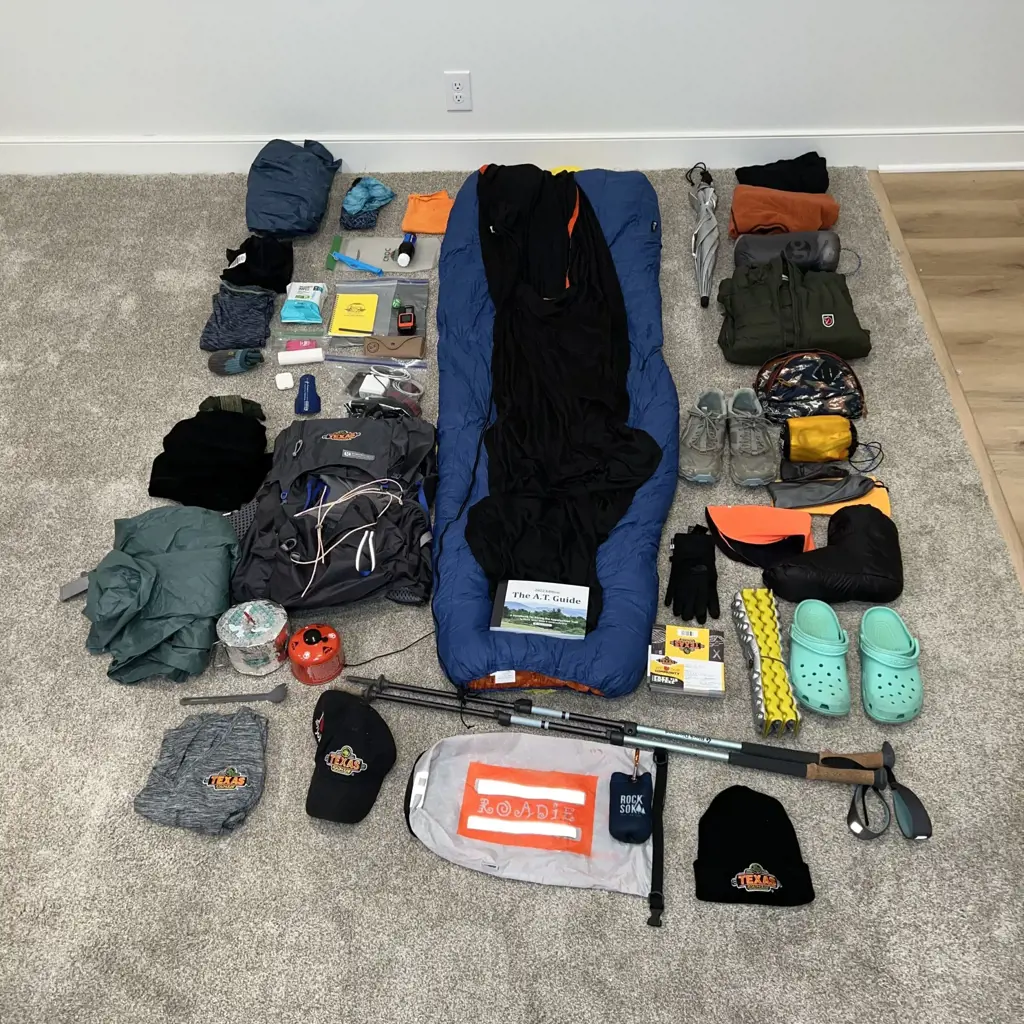
When venturing on a hike along the Appalachian Trail, it is crucial to adequately prepare and pack the essential items to ensure a safe and enjoyable experience. The Appalachian Trail spans over 2,190 miles and passes through various terrains, climates, and elevation changes. Here are a few key items that hikers should consider including in their backpacks to ensure a successful journey.
- Navigation Tools: It is essential to have access to accurate navigation tools to stay on the designated trail. A detailed map of the Appalachian Trail, a compass, and a GPS device can help hikers navigate through different sections of the trail. These tools are especially crucial in case of unexpected detours or in instances where specific sections of the trail may be closed or under maintenance.
- Shelter: A reliable shelter is vital for overnight stays along the trail. The choice between a tent, hammock, or tarp shelter depends on personal preference and the expected weather conditions. A lightweight and waterproof tent is a common choice, providing protection against rain and insects. Hikers should also consider including a groundsheet or footprint to protect their tent from moisture and wear.
- Sleeping Gear: Adequate sleep is crucial for hikers to maintain physical and mental wellbeing on the trail. A high-quality sleeping bag rated for the expected temperatures should be packed. The sleeping bag should be lightweight and compressible to save space in the backpack. Additionally, an insulated sleeping pad or lightweight camping mattress can provide extra comfort and insulation from the ground.
- Cooking and Food: Hikers on the Appalachian Trail need to pack lightweight and nutritious food options. A portable stove, fuel, and cookware are required for preparing meals. Hikers can choose from various lightweight options, such as a backpacking stove or a Jetboil. Food should be lightweight, non-perishable, and provide sufficient calories for the physical demands of the hike. Items like dehydrated meals, energy bars, nuts, and dried fruits are popular choices.
- Water: Staying hydrated is crucial during any hike, especially on long-distance trails like the Appalachian Trail. Hikers should plan for water sources along the trail, such as natural springs, rivers, or water pumps. To ensure safe drinking water, hikers should carry a water filter or purification system. Water bottles or a hydration bladder can be used to carry and consume water throughout the hike.
- Clothing: Appropriate clothing is essential to protect hikers from various weather conditions along the trail. Layering is key to adjust to temperature changes throughout the day. Hikers should pack moisture-wicking and breathable clothing to stay dry and comfortable, such as synthetic or merino wool base layers. A lightweight and waterproof jacket is essential to protect against rain and wind. Additionally, extra socks, a hat, gloves, and a buff or bandana can provide added protection and comfort.
- First Aid Kit: Accidents and injuries can happen while hiking, so it is crucial to carry a well-stocked first aid kit. The kit should include bandages, gauze pads, adhesive tape, antiseptic wipes, pain medication, blister treatment, and any necessary personal medications. It is important to be familiar with how to use the items in the first aid kit and seek medical assistance if needed.
- Personal Hygiene and Toiletries: Maintaining personal hygiene is essential for overall wellbeing on the trail. Hikers should pack travel-sized toiletries, including biodegradable soap, toothpaste, toothbrush, toilet paper, and hand sanitizer. Proper waste disposal is important, so hikers should also include waste bags or a trowel for burying human waste.
- Lighting: Having a reliable light source allows hikers to navigate in the dark and ensure their safety. A headlamp or a small flashlight should be included in the backpack. These lights should have extra batteries or be rechargeable. Hikers can also consider carrying a small lantern for additional area lighting at the campsite.
- Miscellaneous: A few additional items that hikers may want to consider include a multi-tool or Swiss Army knife for various tasks, a whistle for emergency signaling, insect repellent, sunscreen, a bear canister for food storage in bear-populated areas, and a lightweight dry bag or waterproof cover for protecting electronics and important documents from moisture.
When packing for a hike on the Appalachian Trail, it is essential to strike a balance between carrying necessary gear and keeping the backpack weight manageable. Minimizing weight while still ensuring safety and comfort will enable hikers to fully enjoy the breathtaking beauty and challenges of this iconic trail.
Essential Items to Pack for a Trip to Sandals Jamaica
You may want to see also

How should clothing choices be made to accommodate the changing weather conditions on the Appalachian Trail?
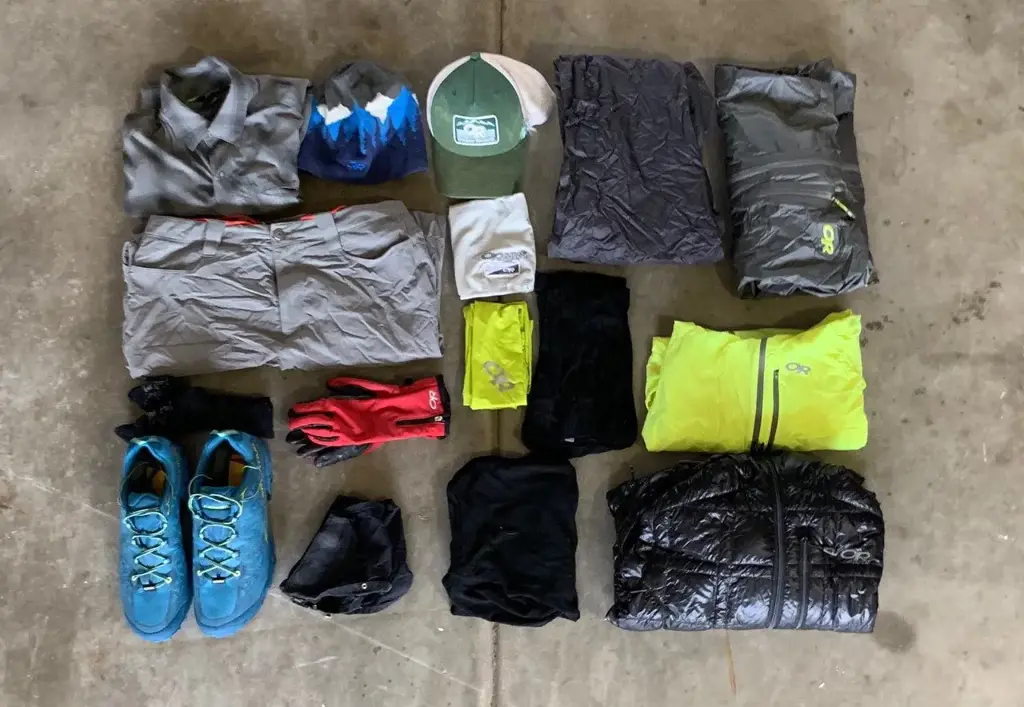
How to Choose the Right Clothing for Changing Weather Conditions on the Appalachian Trail
The Appalachian Trail is a majestic and challenging hiking route that spans over 2,000 miles, passing through 14 states. One of the key factors to consider when hiking the Appalachian Trail is the ever-changing weather conditions. The trail can experience a wide range of temperatures, precipitation, and even extreme weather events. Therefore, it is essential to make thoughtful clothing choices to ensure comfort, safety, and enjoyment throughout your trek. In this article, we will discuss some science-backed tips, personal experiences, and provide step-by-step instructions on how to choose the right clothing for the changing weather conditions on the Appalachian Trail.
Understand the Layering System:
The layering system is a tried-and-true method of dressing for variable weather conditions. It involves wearing multiple layers that can be added or removed as needed to regulate body temperature. The three main layers are base layer, insulation layer, and outer shell.
- Base Layer: The base layer is the one closest to your skin and should be moisture-wicking to keep you dry. Synthetic materials like polyester or merino wool are excellent choices.
- Insulation Layer: The middle layer provides warmth and insulation. Fleece jackets or down vests are lightweight and efficient at trapping heat.
- Outer Shell: The outer shell is your protection against wind, rain, and snow. Look for a waterproof and breathable jacket with sealed seams.
Research the Weather Forecast:
Before embarking on your Appalachian Trail adventure, check the weather forecast for each section you'll be hiking. This will give you an idea of the expected conditions and help you pack accordingly. Remember, weather can change rapidly, so always be prepared for unexpected changes.
Consider the Season:
The Appalachian Trail experiences four seasons, each with its own weather patterns. For example, summer months can be hot and humid, while winter brings freezing temperatures and snowfall. Research the typical weather patterns for the season you'll be hiking and pack clothing suitable for those conditions. Be aware of shoulder seasons when weather can be particularly unpredictable.
Choose Lightweight and Quick-Drying Fabrics:
The weight of your clothing can significantly impact your hiking experience. Opt for lightweight and quick-drying fabrics like nylon or polyester. These fabrics will keep you cool when it's hot, dry fast when wet, and are easy to pack.
Bring Versatile Clothing Items:
Select clothing items that can be used in multiple ways to maximize their utility. For example, convertible pants that can be transformed into shorts, long-sleeved shirts that can be rolled up, or versatile headwear that can protect you from the sun, wind, or rain.
Don't Forget About Accessories:
Accessories play a crucial role in protecting your extremities from the elements. Pack a good pair of hiking boots that are waterproof and offer ankle support. Additionally, bring gloves, hats, and a buff or scarf to protect your hands, head, and neck from biting winds or sunburn.
Personal Experience:
As an experienced hiker who has completed the Appalachian Trail, I can attest to the importance of proper clothing choices. During my journey, I encountered unpredictable weather conditions ranging from scorching heat to freezing rain. Following the tips outlined above, I successfully navigated through different terrains and weather variations. Having the right clothing allowed me to stay comfortable, dry, and safe, ultimately enhancing my overall hiking experience.
In conclusion, choosing the right clothing for the changing weather conditions on the Appalachian Trail is crucial for a successful and enjoyable hike. By understanding the layering system, researching the weather forecast, considering the season, selecting lightweight fabrics, choosing versatile clothing items, and packing essential accessories, hikers can be prepared for whatever Mother Nature might throw their way. So, before setting off on your next adventure along the Appalachian Trail, make sure your clothing choices align with the ever-changing weather conditions!
Essential Items to Pack on Your Snowboarding Trip
You may want to see also

Are there any specific gear or equipment recommendations for hiking the Appalachian Trail?
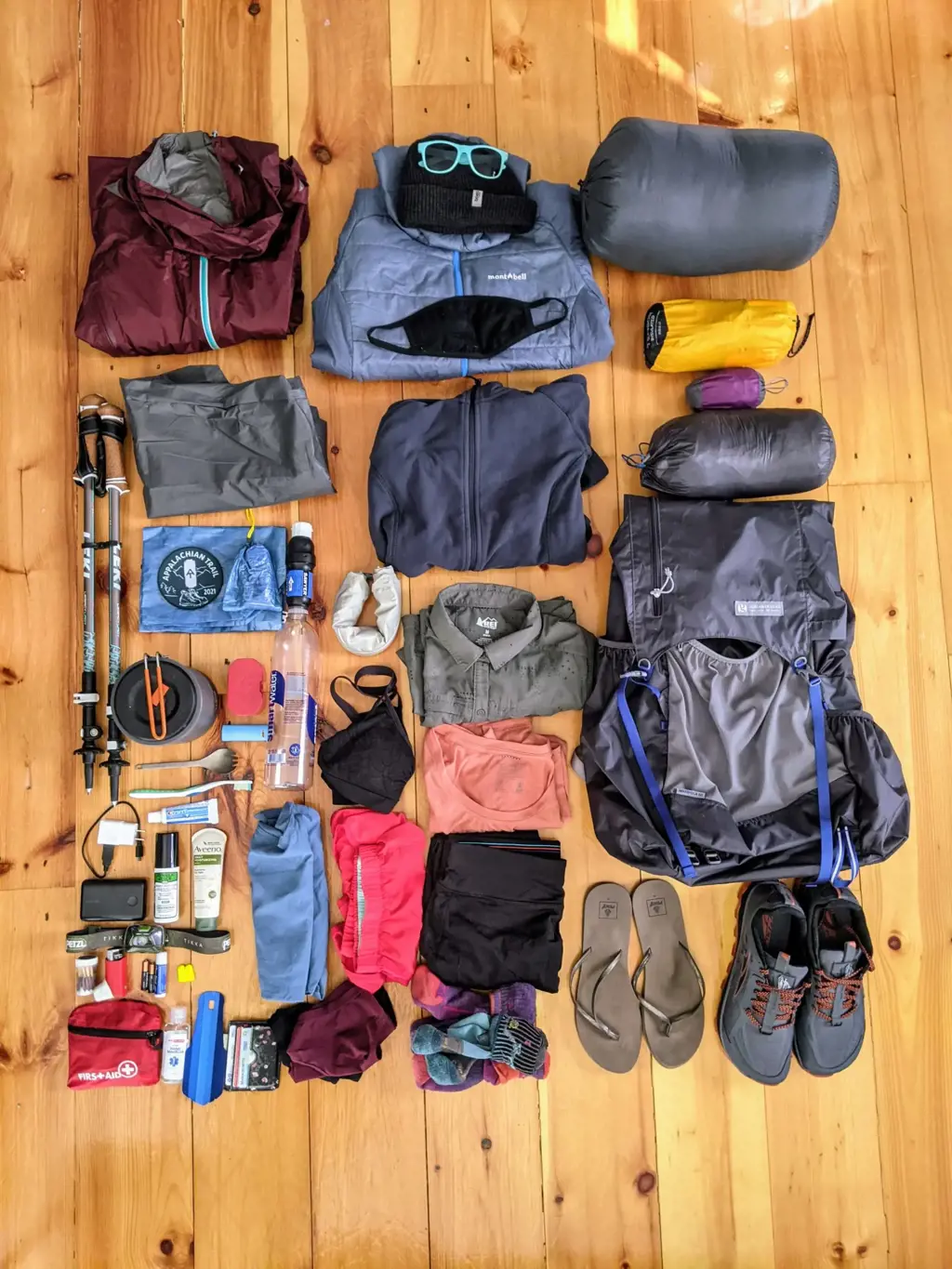
If you are planning to hike the Appalachian Trail, it is important to be well-prepared with the right gear and equipment. The trail spans over 2,000 miles and passes through varied terrain and weather conditions, so having the appropriate gear can make a significant difference in your comfort and safety. Here are some specific gear and equipment recommendations for hiking the Appalachian Trail.
- Backpack: Invest in a lightweight and durable backpack with a capacity of around 50-70 liters. Look for a backpack that has a good suspension system to distribute the weight evenly and has adjustable straps for a comfortable fit.
- Tent: A lightweight and spacious tent is essential for shelter along the trail. Look for a tent with good ventilation to prevent condensation and a waterproof rainfly to protect you from the elements. There are many ultralight options available that are specifically designed for backpacking.
- Sleeping bag: Choose a sleeping bag that is suitable for the weather conditions you will encounter on the trail. A sleeping bag with a temperature rating of 20-30 degrees Fahrenheit is usually sufficient for most sections of the trail. Consider the weight and packability of the sleeping bag, as you will have to carry it in your backpack.
- Sleeping pad: A good quality sleeping pad is crucial for a comfortable night's sleep on the trail. Look for a lightweight and packable sleeping pad that provides insulation from the cold ground. Foam or inflatable pads are popular options among hikers.
- Clothing: Dressing in layers is the key to staying comfortable on the trail. Choose moisture-wicking and quick-drying materials for your base layer. Pack lightweight and versatile options such as convertible pants, a lightweight down jacket, a rain jacket, and a hat to protect against the sun or rain. Don't forget to pack extra socks to keep your feet dry and avoid blisters.
- Footwear: Invest in a sturdy and comfortable pair of hiking boots or trail runners. Make sure they are broken in before you start your hike to avoid blisters and discomfort. Consider using gaiters to keep debris out of your boots and to protect your ankles.
- Water purification: The Appalachian Trail passes through many water sources, but it is essential to treat the water before drinking it. Carry a lightweight water filter or a water purification system to remove harmful bacteria and parasites. You can also use water purification tablets or a UV light device for convenience.
- Cooking equipment: A lightweight and compact backpacking stove and cookware set are necessary for preparing meals on the trail. Look for a stove that is fuel-efficient and easy to use. Consider using a lightweight titanium or aluminum cookware set to minimize weight.
- Navigation tools: Carry a map and compass as a backup for navigation, even if you are relying on a GPS or smartphone app. Learn how to use them before your hike. Consider a GPS device or smartphone app that allows you to navigate the trail easily.
- First aid kit: It is crucial to have a well-stocked first aid kit, including bandages, antiseptic ointment, pain relievers, blister treatment, and any personal medications. Learn basic first aid skills before your hike.
Remember to do thorough research and consult with experienced hikers or outdoor gear specialists to find the best gear and equipment for your specific needs and preferences. Ultimately, having the right gear will enhance your hiking experience and ensure your safety on the Appalachian Trail.
7 Essential Items to Pack for Your Trip to Italy
You may want to see also

What type of footwear is recommended for hiking long distances on the Appalachian Trail?
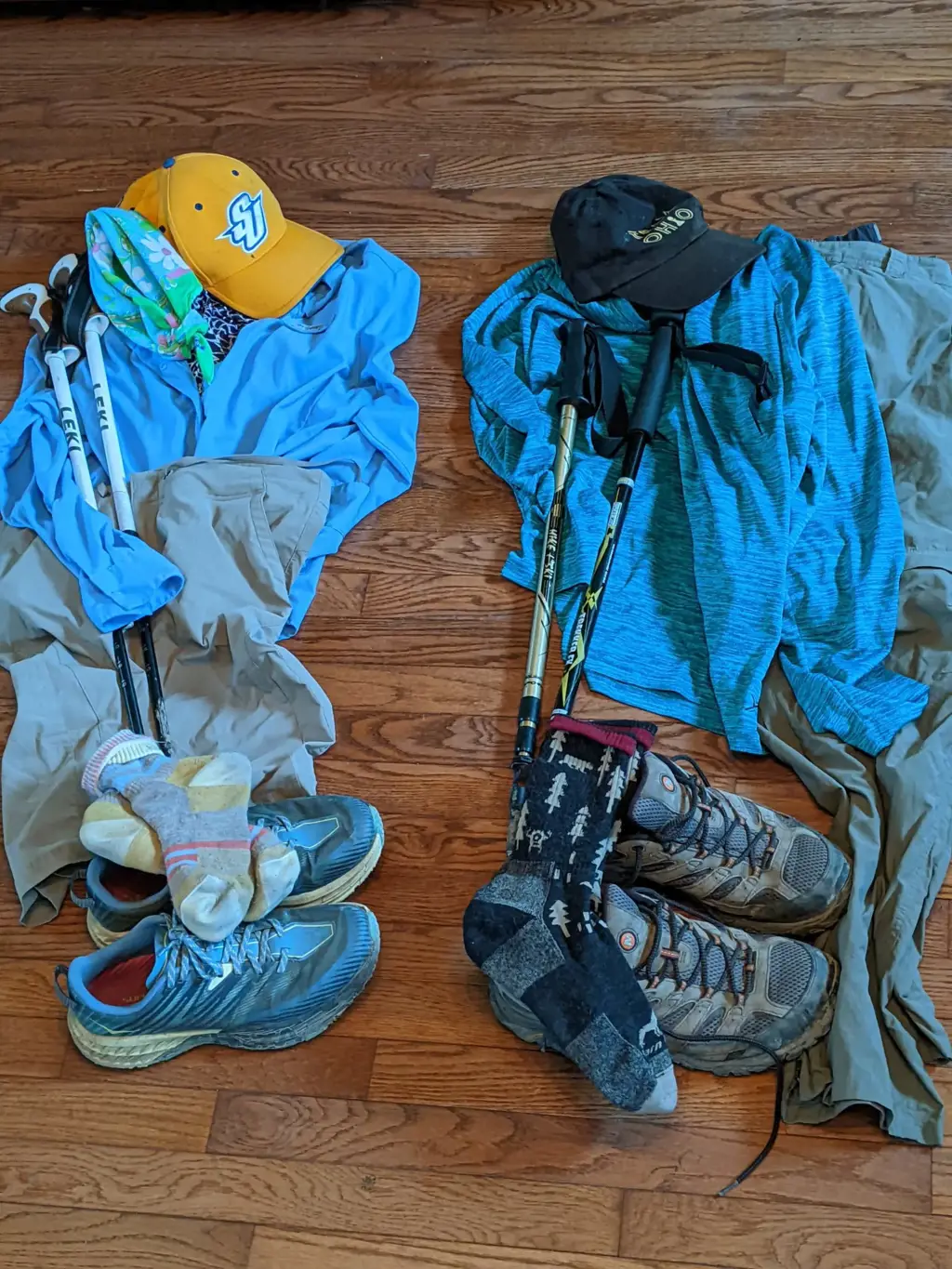
When it comes to hiking long distances on the Appalachian Trail, having the right type of footwear is essential. The Appalachian Trail is a rugged and challenging trail that spans over 2,000 miles, so it's important to choose a pair of shoes that can provide the necessary support and durability. In this article, we will discuss the different types of footwear that are recommended for hiking long distances on the Appalachian Trail.
- Hiking Boots: Hiking boots are a popular choice among hikers on the Appalachian Trail. They are designed to provide ankle support and protection against rough terrain. Hiking boots are typically made with waterproof materials, which can be helpful when hiking through wet and muddy areas. Look for boots with a sturdy sole that provides good traction and stability.
- Trail Running Shoes: Some hikers prefer to wear trail running shoes instead of hiking boots. Trail running shoes are lightweight and offer a more flexible sole, allowing for a more natural foot movement. They are designed for speed and agility on rugged trails. However, trail running shoes may not provide as much ankle support as hiking boots, so it's important to consider the level of support needed for your individual hiking style.
- Hiking Sandals: For hikers who prefer a more breathable and lightweight option, hiking sandals can be a good choice. Hiking sandals are designed with open toes and breathable materials, making them ideal for hiking in hot weather. They are also quick-drying, which can be advantageous when crossing streams or encountering wet conditions. However, hiking sandals may not provide as much protection against rough terrain or sharp objects, so they are best suited for well-maintained sections of the trail.
- Hiking Shoes: Hiking shoes offer a middle ground between hiking boots and trail running shoes. They provide more support and protection than trail running shoes, but are lighter and more flexible than hiking boots. Hiking shoes are a great option for hikers who want a balance between durability and comfort. They are also suitable for various terrains, including rocky and uneven surfaces.
It's important to note that choosing the right footwear for hiking the Appalachian Trail is a personal decision. What works for one hiker may not work for another. It's recommended to try on different types of shoes and go for a few test hikes before embarking on a long-distance hike. This will allow you to determine which type of footwear provides the best fit, support, and comfort for your feet.
In conclusion, the type of footwear recommended for hiking long distances on the Appalachian Trail can vary depending on individual preference and hiking style. Hiking boots, trail running shoes, hiking sandals, and hiking shoes are all viable options, each with their own advantages and considerations. It's important to choose footwear that provides the necessary support, durability, and comfort for the rugged and challenging conditions of the trail.
What to Pack for Your Orlando Adventure
You may want to see also

Are there any safety items or emergency supplies that should be included in a backpack for the Appalachian Trail hike?

Heading: Are there any safety items or emergency supplies that should be included in a backpack for the Appalachian Trail hike?
Introduction:
When embarking on a hike along the Appalachian Trail, safety should be a top priority. The trail spans over 2,200 miles, passing through diverse and sometimes challenging terrain. It is essential to prepare for any unforeseen circumstances by carrying the proper safety items and emergency supplies. This article will outline the necessary gear and supplies to include in your backpack to ensure a safe and enjoyable experience on the Appalachian Trail.
Navigation Tools:
One of the first items to include in your backpack is a map and compass. While the trail is well-marked, it's always wise to carry these tools in case of accidental detours or if you need to navigate off the beaten path. Additionally, a GPS device or smartphone with a trail map app can serve as a backup navigation tool.
First Aid Kit:
A comprehensive first aid kit is an essential item for any hike. Make sure to include band-aids, adhesive tape, antiseptic wipes, butterfly closures, gauze pads, blister treatment, tweezers, and any necessary personal medication. It's crucial to be prepared to treat minor injuries and ailments that may occur while on the trail.
Water Filter or Purification Tablets:
Access to clean drinking water is not always readily available along the Appalachian Trail. Carrying a water filter or purification tablets is crucial to ensure you can safely drink from natural water sources. This will save you from having to carry large amounts of water, lightening your backpack and allowing you to hike longer distances.
Emergency Shelter:
In case of unexpected weather conditions or emergencies, it's essential to have a lightweight emergency shelter, such as a tarp or bivvy sack. These shelters can provide protection from rain, wind, and cold temperatures, giving you a safe place to wait out severe weather or spend the night if necessary.
Fire Starter:
A fire starter, such as waterproof matches or a lighter, should be included in your emergency supplies. Fire can provide warmth, cook meals, and serve as a distress signal if needed. Familiarize yourself with fire safety techniques and regulations before lighting a fire along the trail.
Food and Extra Supplies:
Always carry enough food to sustain yourself for the duration of your hike, plus a few extra days in case of unexpected delays or emergencies. Choose lightweight, high-calorie options, such as energy bars and dehydrated meals. Additionally, pack extra batteries, a headlamp, a multi-tool, and a repair kit for your gear.
Communication Devices:
Carry a cell phone with a fully charged battery as a primary communication device. While cell service may be limited along the trail, there are usually areas where you can get a signal. Additionally, consider carrying a Personal Locator Beacon (PLB) or Satellite Messenger device, which enables you to send SOS signals and communicate your location in emergencies.
When embarking on a hike along the Appalachian Trail, including the above safety items and emergency supplies in your backpack is essential for a successful and safe journey. By prioritizing your safety, you can enjoy the stunning trail while being prepared for any unforeseen circumstances that may arise. Remember to always research and stay up-to-date on hiking safety guidelines and regulations before setting foot on the trail.
Essential Items to Pack for a Memorable Trip to the Bahamas
You may want to see also
Frequently asked questions
When hiking the Appalachian Trail, it is important to pack lightweight and essential items. Some items that are recommended to pack include a backpack, tent, sleeping bag, cooking utensils, water filter, first aid kit, hiking boots, clothing layers, and lightweight food.
It is recommended to pack enough clothing for a week on the trail. This includes a few pairs of moisture-wicking hiking socks, a few changes of base layers, a few t-shirts or lightweight tops, a fleece or down jacket for warmth, a rain jacket and rain pants for wet weather, a warm hat and gloves, and a pair of hiking pants or shorts.
A good pair of hiking boots is essential for hiking the Appalachian Trail. Look for boots that are lightweight, waterproof, and provide good ankle support. It is also recommended to break in your boots before you start your hike to prevent blisters and discomfort.
The amount of food and water you should pack depends on the length of your hike and the availability of resupply points along the trail. It is generally recommended to carry enough food for 3-5 days and to drink at least 2 liters of water per day. It is also important to have a good water filter or purification method to ensure you have access to clean drinking water along the trail.







